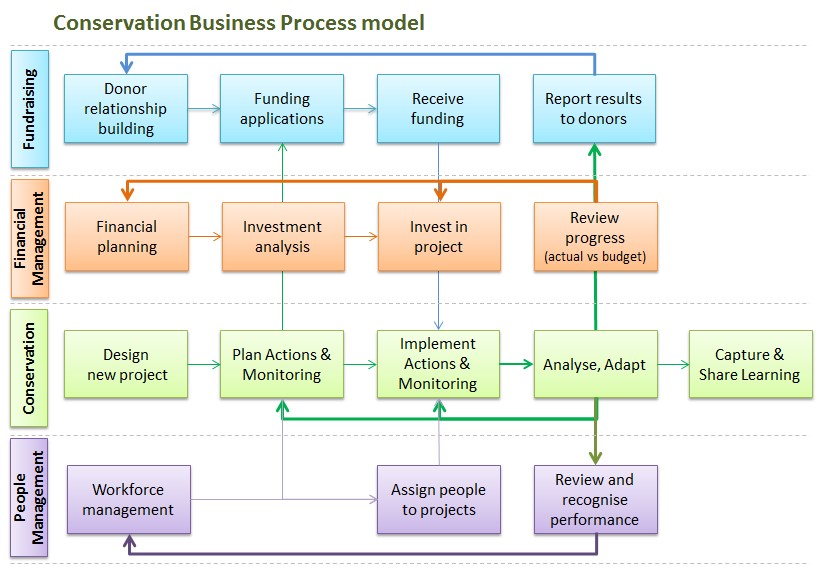Story from Annette Stewart, Bush Heritage Australia
Last year, I was the lucky recipient of a Fulbright scholarship to study how other conservation organisations manage their work. I see the Open Standards as a useful approach to designing and implementing individual conservation projects, but I was curious to see what happens when you need to manage a broad portfolio of projects, or a whole conservation business. I wanted to learn how the Open Standards might help an organisation make better investment decisions, juggle competing priorities, and allocate funding and resources across a portfolio.
Identifying Conservation Business Challenges
I completed several case studies with conservation practitioners and spoke to a wide range of people in financial management, fundraising, personnel management, and other support roles within small and medium-sized organisations. I also met with several academics and business leaders with experience in organisational performance and organisational change.
People in support roles identified common challenges like needing to “speak a different language” for each project, constantly chasing down and re-entering project information, and making decisions without full insight into the bigger picture. They often said that their work would be much more efficient and effective if they had easy access to consistent, up-to-date information on the organisation’s conservation projects.
The Benefits of Using the Open Standards for Business Processes
For organisations to be efficient, the flow of information between processes is as critical as the flow within processes. In my view, using the Open Standards, and supporting systems like Miradi and Miradi Share, can help create efficient workflows. These tools standardise information and leverage technology, making it easier to enter and integrate data across systems and processes. This gives organisations a more comprehensive understanding of priorities and progress and helps them learn what’s working and what isn’t.
I found little awareness of these broader business benefits among organisation leadership and support staff. Their interest piqued when I demonstrated the possible benefits using real-world examples; however, organisation leaders are reluctant to “mandate” particular approaches. Leaders are more likely to respond to a broad ground-swell for change, yet very few practitioners have the time or scope to help generate change. In our discussions, practitioners reported that they are under-resourced and have little or no time to look at anything beyond their immediate project; they don’t even have time to consider improved ways of doing things.
Moving Forward
Throughout my work, an old quote kept ringing in my ears: we’re all “too busy chopping down trees to stop and sharpen the axe.” We’re making progress though. While my scholarship period has completed, I’m pushing ahead with a few tasks including raising funds required to make the Open Standards tools better support business systems. I’m keen to collaborate with anyone who has an interest in this area—please get in touch. Many thanks to all the Conservation Measurement Partnership and CCNet folks who helped me during my project. I’ve learned a lot from all of you.
If you are working across multiple projects, or trying to get broader adoption of Open Standards within your organisation, you might find it useful to explore the toolkit of supporting documents and short videos explaining some of the concepts.
- Further details of the Conservation Business Process Model and how the Open Standards fit within common business performance frameworks
- A draft Conservation Capability Maturity Model that helps organisations assess their current capabilities and identify areas for improvement
- An overview of the Environmental Impact Investing market, which demands the highest levels of efficiency and effectiveness, but potentially offers significant new funding for conservation.
You can read more on the insights from my study in my Summary Report to CMP.
This “swim lane” diagram illustration organisation-wide use of conservation project information. It shows the core process of conservation using the five steps of the Open Standards alongside the key steps occurring in other parts of a generic medium-sized organisation. The arrows show key information flows. The thicker lines show the critical feedback loops. All feedback loops start with the analysis of project progress against the expected results.For example, information from a conservation project plan is required to inform the organisation’s investment decisions and funding applications; once projects are funded, progress information must be reported back to donors. If progress information doesn’t flow easily and regularly, donor relations are extremely difficult to maintain. Good donor relations are required to support the organisation’s work and sustainability.

